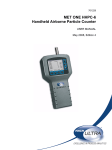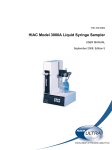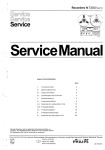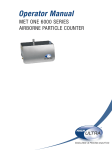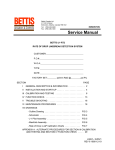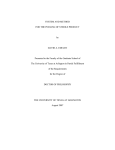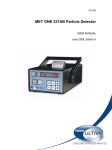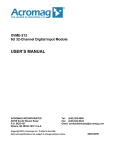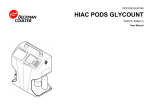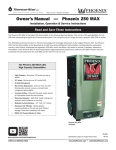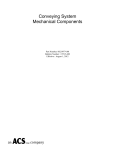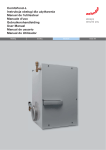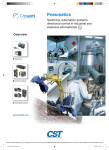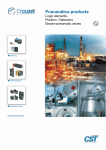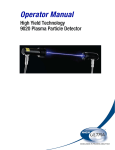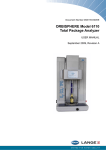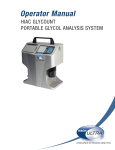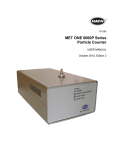Download HIAC Model ABS-2 Automatic Bottle Sampler
Transcript
700-100-0040 HIAC Model ABS-2 Automatic Bottle Sampler USER MANUAL September 2008, Edition 3 Table of Contents Section 1 Specifications .................................................................................................................... 3 Section 2 General Information ......................................................................................................... 5 2.1 Disclaimer .................................................................................................................................... 5 2.2 Safety information ........................................................................................................................ 5 2.2.1 Use of hazard information................................................................................................... 5 2.2.2 Precautionary labels ........................................................................................................... 6 2.3 Safety recommendations ............................................................................................................. 6 Section 3 Installation and Device Familiarization ....................................................................... 7 3.1 General ........................................................................................................................................ 7 3.2 System configuration ................................................................................................................... 7 3.3 Installation.................................................................................................................................... 8 3.3.1 Inspection and unpacking ................................................................................................... 8 3.3.2 Positioning .......................................................................................................................... 8 3.3.3 Standard precautions.......................................................................................................... 8 3.3.4 Safety precautions .............................................................................................................. 8 3.4 Device familiarization ................................................................................................................... 9 3.4.1 Controller board .................................................................................................................. 9 3.4.2 Optical level detectors......................................................................................................... 9 3.4.3 Sample transport system .................................................................................................... 9 3.4.4 Front panel........................................................................................................................ 10 3.4.5 Rear panel ........................................................................................................................ 12 3.5 Equipment connections.............................................................................................................. 13 3.5.1 External equipment ........................................................................................................... 13 3.5.2 Accessory kit..................................................................................................................... 14 3.5.3 Front panel connections.................................................................................................... 14 3.5.4 Sensor installation............................................................................................................. 15 3.5.5 Ball valve installation......................................................................................................... 15 3.5.6 Rear panel connections .................................................................................................... 16 3.5.7 External equipment ........................................................................................................... 17 Section 4 Controls and Operations .............................................................................................. 19 4.1 General ...................................................................................................................................... 19 4.2 Operator controls ....................................................................................................................... 19 4.2.1 Description ........................................................................................................................ 20 4.2.2 Sampler operations........................................................................................................... 22 4.2.3 Vacuum operations ........................................................................................................... 24 4.2.4 Electromagnetic stir assembly .......................................................................................... 24 4.2.5 System dead (tare) volume............................................................................................... 24 Section 5 Maintenance and Troubleshooting ............................................................................ 25 5.1 General maintenance................................................................................................................. 25 5.2 Sight tube cleaning .................................................................................................................... 25 5.3 ABS-2 system maintenance....................................................................................................... 26 5.3.1 Line filter (P/N 188-039).................................................................................................... 27 5.3.2 Desiccant chamber (P/N 395-019).................................................................................... 27 5.3.3 Check valve ...................................................................................................................... 27 5.3.4 Micrometer valve bypass for highly viscous fluids ............................................................ 28 5.3.5 Line pressure drier (P/N 570-800-0006) ........................................................................... 29 5.3.6 ABS-2 line fuse ................................................................................................................. 29 5.3.7 Air pump power outlet ....................................................................................................... 30 5.3.8 Air pump fuse.................................................................................................................... 30 5.3.9 Pinouts .............................................................................................................................. 31 5.4 ABS-2 troubleshooting ............................................................................................................... 31 1 Table of Contents 5.5 Spare parts.................................................................................................................................32 Section 6 Warranty and Contact Information .............................................................................33 6.1 Limited warranty .........................................................................................................................33 6.2 Service contact information ........................................................................................................34 6.2.1 U.S.A. customers...............................................................................................................34 6.2.2 International customers .....................................................................................................34 6.2.3 Information required ..........................................................................................................34 6.3 Return for repair .........................................................................................................................34 Section 7 Certification ......................................................................................................................35 2 Section 1 Specifications Specifications are subject to change without notice. Performance characteristics Sample flow rate 1 - 200 mL/min (user adjustable) Fluid viscosity dependant Sample volume: 5 - 100mL (user adjustable) 5 mL increments Dead (Tare) volume: 16 mL Sample accuracy: ±5% of selected volume Repeatability: ±1% Fluid compatibility: Fluids compatible with stainless steel, glass, and TeflonTM Operating pressure range: Minimum: 20 PSI (34 kPa) recommended Maximum: 50 PSI (344.7 kPa) Physical characteristics Dimensions: 12.75 inches (32.4cm) W 18 inches (45.7cm) L 27 inches (68.6cm) H Weight: 50Lb.(22.7kg) Power requirements Factory set: 90 - 130 V, 47 - 63 Hz ±1% (@ <1.0 A) 180 - 260 V, 47 - 63 Hz ±1% (@ < 0.5 A) With optional pump: 90 - 130 V, 47 - 63 Hz ±1% (@ < 6.25 A) 180 - 260 V, 47 - 63 Hz ±1% (@ < 5.0 A) Environmental Temperature range: Operating: +50 to +104°F (+10 to +40°C) Non-Operating: -40 to +149°F (-40 to +65°C) Relative humidity: Atmospheric pressure: 10 - 80% RH (Non-condensing) Operating: Sea Level to 10Kft. (3048m) Non-Operating: Sea Level to 50Kft. (15240m) Input/Output Host Control I/O: RS 232 (DB-25 female) 3 Specifications 4 Section 2 General Information 2.1 Disclaimer The information in this manual has been carefully checked and is believed to be accurate. However, Hach Ultra assumes no responsibility for any inaccuracies that may be contained in this manual. In no event will Hach Ultra be liable for direct, indirect, special, incidental, or consequential damages resulting from any defect or omission in this manual, even if advised of the possibility of such damages. In the interest of continued product development, Hach Ultra reserves the right to make improvements in this manual and the products it describes at any time, without notice or obligation. Copyright © 2008 by Hach Ultra. All rights reserved. No part of the contents of this manual may be reproduced or transmitted in any form or by any means without the written permission of Hach Ultra. 2.2 Safety information Read this entire manual before unpacking, setting up or operating this equipment. Pay attention to all danger and caution statements. Failure to do so could result in serious injury to the operator or damage to the equipment. To make sure that the protection provided by this equipment is not impaired, do not use or install this equipment in any manner other than that specified in this manual. 2.2.1 Use of hazard information DANGER Indicates a potentially or imminently hazardous situation which, if not avoided, will result in death or serious injury. WARNING Indicates a potentially or imminently hazardous situation which, if not avoided, could result in death or serious injury. CAUTION Indicates a potentially hazardous situation that can result in minor or moderate injury. Important Note: Indicates a situation which, if not avoided, can cause damage to the instrument. Information that requires special emphasis. Note: Information that supplements points in the main text. 5 General Information 2.2.2 Precautionary labels Read all labels and tags attached to the instrument. Personal injury or damage to the instrument could occur if not observed. A symbol, if noted on the instrument, will be included with a danger or caution statement in the manual. This symbol, if noted on the instrument, references the instruction manual for operation and/or safety information. Electrical equipment marked with this symbol cannot be disposed of in European public disposal systems after 12 August of 2005. In conformity with European local and national regulations (EU Directive 2002/96/EC), European electrical equipment users must now return old or end-of life equipment to the Producer for disposal at no charge to the user. Note: To return for recycling, contact the equipment producer or supplier for instructions on how to return end-of-life equipment, producer-supplied electrical accessories and all auxiliary items for proper disposal. This symbol, when noted on a product enclosure or barrier, indicates that a risk of electrical shock and/or electrocution exists. This symbol, if noted on the product, indicates the need for protective eye wear. This symbol, when noted on the product, identifies the location of a fuse or current limiting device. This symbol, if noted on the product, indicates a crush hazard. Keep hands and fingers clear This symbol, when noted on the product, indicates the presence of devices sensitive to Electro-static Discharge (ESD) and indicated that care must be taken to prevent damage with the equipment. 2.3 Safety recommendations WARNING To reduce the risk of electric shock do not remove the cover or the back while the instrument is powered. Refer all servicing of this instrument to qualified service personnel. Prior to operating this instrument read the Operations Manual to become familiar with the operation of this instrument. Failure to follow the operating procedures may result in damage to this instrument and voiding of the warranty. This instrument requires the operator to be familiar with the operation of analytical instrumentation and have an understanding of particle counting applications. Note: This instrument has been tested and found to comply with the limits for a Class A digital device, pursuant to Part 15 of the FCC rules. These limits are designed to provide reasonable protection against harmful interference when the instrument is operated in a commercial environment. This instrument generates, uses, and can radiate radio frequency energy and, if not installed and used in accordance with the Operations Manual, may cause harmful interference to radio communications. Operation of this instrument in a residential area is likely to cause harmful interference, in which case the user will be required to correct the interference at his/her own expense. Note: This instrument is Installation Category II as defined by IEC 1010-1, Annex J. 6 Section 3 Installation and Device Familiarization DANGER Tasks involving installation of this equipment have electrical related hazards associated with them. These tasks must only be attempted by individuals trained and knowledgeable in this particular task and associated hazards. 3.1 General This chapter explains the installation of the Automatic Bottle Sampler, ABS-2. The ABS-2 is an essential part of a batch fluid analysis system. Check the individual peripheral equipment manuals for the mechanical/electrical installation and operating procedures required to incorporate an ABS-2. Consult with Hach Ultra Technical Support to resolve any compatibility or suitability questions regarding a specific application. The ABS-2 may be used in conjunction with HIAC particle sensors and counters. The sampler's design provides a means of metering a known volume of liquid sample through a sensor while generating start and stop signals for a counter. The operator adjusts the volume by setting the positions of photoelectric level detectors on the ABS-2 sight tube. The ABS-2 operates by either pressurizing the sample liquid for transport through the sensor or by evacuating the sample chamber (vacuum mode), degassing the sample prior to analysis. The ABS-2 will operate either manually, with the operator prompting the ABS-2 to begin and end the sampling procedure, or automatically, with the ABS-2 sampling when prompted remotely by the host particle counter. The ABS-2, when prompted by a host counter, can perform multiple sample analyses (batch sampling). The ABS-2 pressure chamber's electromagnetic stir assembly incorporates solid state technology to ensure sample stability and reduce particle dropout during analysis. 3.2 System configuration Figure 1 shows a typical system configuration utilizing the ABS-2 Automatic Bottle Sampler. Figure 1 Typical ABS-2 system configuration (not to scale) 7 Installation and Device Familiarization 3.3 Installation 3.3.1 Inspection and unpacking The ABS-2 is shipped in a single shipping carton. This carton should be retained for use in case reshipment is required. The carton should be given a visual inspection for signs of external shipping damage. Deficiencies should be brought to the attention of the carrier. All materials received within the shipping carton should be verified against the shipping papers to assure receipt of all materials. An internal inspection should be made of the carton to determine if there has been damage to the contents or if items are missing. Damage to the contents should be brought to the attention of the carrier. Missing items should be brought to the attention of your Hach Ultra representative. 3.3.2 Positioning The following are suggestions and requirements for the positioning of the ABS-2: • The ABS-2 should be mounted on a level surface, at a convenient work level. • The ABS-2 should not be placed in an area where it will be subjected to electronic noise and mechanical vibration. • The ABS-2 must be located within seven feet (2.1 meters) of the grounded electrical power receptacle. Extension cords should not be used. • When sampling hazardous materials, the ABS-2 should be located adjacent to or in a fume hood. • Provide adequate access for operation and maintenance. 3.3.3 Standard precautions The ABS-2 transports fluids through a particle sensor. The following items are standard precautions that must be considered due to the use of pressure in the ABS-2: 1. Attach all pressure and sampling tubing associated with the ABS2 and tighten the fittings prior to applying pressure to the system. 2. Always apply power to the electrical components of the system before pressurization of the fluid system. 3. Never make or break any power or electrical connections when the system is either powered-on or pressurized. 3.3.4 Safety precautions The ABS-2 transports and directs fluids under pressure. The operator should always wear proper safety equipment and clothing when operating or performing any maintenance on the pressurized fluid system. CAUTION Always wear safety glasses and observe safety precautions when working with glass under pressure. Although a safety shield is built into the glass pressure vessel, always inspect the glass pressure chamber for any signs of wear, weakness, or cracking. In the event of glass failure, bubbles will form in the plastic coating on the glass. Should any questions arise contact Hach Ultra Technical Support. WARNING Do not adjust the chamber release/lock handle while the ABS-2 chamber is under pressure. Always depressurize the ABS II pressure chamber prior to tightening or releasing the release/lock handle. 8 Installation and Device Familiarization 3.4 Device familiarization There are three major components to the ABS-2 system: • Controller Board • Optical Level Detectors • Sample Transport System 3.4.1 Controller board An internal controller board allows the ABS-2 to communicate with a host counter and manipulate the flow of the sample. This controller board cycles the system solenoids to accept the sample material, transfers the sample to the volumetric cylinder, makes a volumetric determination, and directs the sample through the sensor. A microvalve located downstream from the sensor ensures sensor backpressure during sampling operations. After the sample has been transported through the sensor, it is directed to a user designated fluid drain. 3.4.2 Optical level detectors The ABS-2 optical level detectors sense the fluid level in the ABS-2 graduated cylinder. The first level detector discerns that the sample has entered into the ABS-2 graduated cylinder at the -0- reference level (or other level set by the operator) and, during the sampling cycle, prompts the counter to start data collection. The second level detector discerns the arrival of the fluid at the user determined volume point (ml) on the graduated cylinder and, during the sampling cycle, prompts the counter to stop data collection. 3.4.3 Sample transport system The sample transport system transfers the sample from the sample chamber through a delivery tube to the sensor, starts and stops the counter for a pre-determined sample volume (ml), and diverts the fluid sample to the user designated waste container. The sampling system consists of a microvalve, two system regulators (pressure and vacuum), and two 12VDC electric solenoid valves. The microvalve, located downstream from the sensor, is used to maintain sensor backpressure during sampling operations and to determine the sample flow rate. The ABS-2 will operate from either an optional pressure/vacuum pump or from house air and vacuum lines. The line pressure is not to exceed 60 PSI (413.7 kPa). 9 Installation and Device Familiarization 3.4.4 Front panel Figure 2 Front panel 10 Installation and Device Familiarization 1. Sensor Mount The location where the sensor is mounted in the upper cavity of the ABS-2. 2. Flow Control Microvalve The microvalve used to control the flow rate of the sample through the sensor. 3. Sample Chamber The pressure or vacuum chamber that maintains sample integrity during sampling operations. 4. Sight Tube The sight tube is used in determining and measuring the sample volume. 5. Chamber Release Handle The release handle will secure the electromagnetic assembly to the pressure chamber when rotated counterclockwise. When the release handle is rotated clockwise, the stir assembly will be release for sample removal. The operator should grasp the stirrer assembly when the assembly is released to prevent sample spilling. 6. Stir Bar Speed Control The stir bar speed control will increase or decrease the stir bar speed. 7. Stir Assembly 8. Vacuum/Pressure Mode Switch The vacuum/pressure mode switch selects the operating mode. When the switch is depressed, the ABS-2 is in the VACUUM Mode and when released, is in the PRESSURE Mode. 9. Manual/Auto Mode Switch The manual/auto mode switch selects the ABS-2's mode of operation. When the switch is depressed, the ABS-2 is in the MANUAL Mode; when the switch is released, the ABS-2 is in AUTOMATIC Mode and under the control of the counter. 10. Pump Control Switch The pump control switch will turn On or Off the optional remote pressure/vacuum pump. 11. Volume Detector 12. Zero Volume Detector 13. Stir Assembly Slide Bar 14. Sample Drip Pan 15. Vacuum Control Valve The vacuum control valve determines the line vacuum for sampling operations. 16. Pressure Control Valve The pressure control valve determines the line pressure for sampling operations. 17. Pressure/Vacuum Gauge The pressure/vacuum gauge indicates the sample line pressure or vacuum. 11 Installation and Device Familiarization 3.4.5 Rear panel Figure 3 Rear Panel Figure 3 shows the service connects on the rear panel of the ABS-2. 12 Installation and Device Familiarization Their functions are: 1. Sensor Cable Port The sensor communications/power cable is placed through this port to the counter. 2. Sampler Communications Port The sample communications cable (P/N 28-0146) is connected to the sampler communications port and to the counter. 3. AC Line Filter/Fuse The AC line cord is connected to the ABS-2 AC line power filter. To replace the ABS-2 fuse, open the fuse door and pull out the fuse holder marked with an arrow. 4. AC Fuse - Pump The fuse for the line power for the optional remote pump. 5. Pressure/Vacuum Pump AC Outlet The port to connect the line power cord from the optional pressure/vacuum pump (P/N 073210-01 115 VAC, 073210-11 220 VAC). 6. Sample Drain Port The sample drain from the sight tube. 7. Vent Outlet The vent from the sample chamber. 8. Vacuum Port The vacuum line for ABS-2 vacuum operations connection. 9. Pressure/Vacuum Exhaust The exhaust for line pressure and vacuum operations. This port must be capped when using facility air and vacuum sources. 10. Pressure Port The pressure line for ABS-2 pressure operations connection. CAUTION The line pressure to the ABS-2 must be externally regulated.The maximum line pressure is 60 psi (443.7kPa). Line pressures exceeding 60 psi will result in permanent damage to the ABS-2. 3.5 Equipment connections As part of the sample transport system, the ABS-2 requires several mechanical and electrical connections. The components to be connected are a regulated pressure line to the ABS-2, sample lines to and from the particle sensor, a drain line, a vent line from the sight tube assembly, AC power, AC power to the optional pump, and an electronic connection to a host counter. The mechanical connections to and from the ABS-2 require either ¼ inch (6.35 mm) or 3/8 inch (9.5 mm) O.D. compression fittings and tubing. All connections should be finger tightened, then tightened one quarter turn with a wrench. Overtightening the connectors will permanently damage the pressure tube seals. It is recommended that when installing the ABS-2 in the system, the sensor installation take place prior to connection of the ABS-2 to service lines. The installation of the sensor into the ABS-2 may be performed before or after the connection of the ABS-2 to the service pressure/vacuum lines and the fluid drain. 3.5.1 External equipment The following is a list of HIAC equipment which is commonly used with the ABS-2: Particle Sensors Counters Model HRLD Model 4100 MicroCount-01, 02, & 05 Model 8000A Model HR-XXX Model 9064 13 Installation and Device Familiarization 3.5.2 Accessory kit The ABS-2 is shipped with an Accessory Kit configured to the power requirements of the user (115 VAC P/N 073X209-01 or 230 VAC P/N 073X209-11). The following materials are supplied in the ABS-2 Accessory Kit and will be called out by Item Number during installation of the ABS-2: Item No. Description Quantity Part No. 1. Cap 1 190-029 2. Fuse (ABS-2): 115 VAC 2 AMP 5X20, MM, SLO-BLO 2 500-150-0200 3. Fuse (Pump): 250 VAC Kit 6.25 AMP, 3AG, SLO-BLO 2 590-033 4. Power Cord 7.5 Ft (229 cm) 1 550-019 5. Cable, Shielded, M/M 1 28-0146 6. Stir Rod .5 inch 5 10000095 7. Stir Rod 1.5 inch 5 073138-03 8. Tube Insert 3/8 OD 1 190-292 9. Tygon Tube 3/8 OD 4 Feet (122 cm) 401-011 3.5.3 Front panel connections The front panel connections are located in the top section of the ABS-2. The sensor is installed on the sample tube connection located in the top of the ABS-2. Figure 4 Front panel connections 14 Installation and Device Familiarization Access to the sensor connections is made by depressing two release buttons located on each side of the top of the ABS-2 (indicated in Figure 4) and placing the cover in an upright position. 3.5.4 Sensor installation The sensor is attached to the sensor microcell connector located on the end of the chamber sampling tube. The sensor's outlet port is connected to the sensor microcell connector outlet sample line. The outlet sample line is connected to the microvalve. Thread the sensor communications cable out through the rear panel of the ABS-2. 3.5.5 Ball valve installation Install the glass ball valve on the glass sight tube located in the top left corner of the ABS-2. Place the check valve loop (indicated in the diagram below) towards the front of the instrument, by gently pressing the ball valve onto the sight tube and turning the ball valve two degrees in either direction. Figure 5 Ball valve 15 Installation and Device Familiarization 3.5.6 Rear panel connections Figure 6 Lower rear panel connections Vent The vent outlet connects a ¼ inch (6.35 mm) O.D. (user supplied) vent service line to a user defined fume exhaust. The vent outlet service line connects to the fume exhaust via a user supplied nut and ferrule. When sampling hazardous fluids or fluids that may produce hazardous vapors, the vent outlet should be connected to a fume exhaust. If the vent outlet is not connected to a fume exhaust, the vapors from the sample fluid will be released to the sampling room atmosphere during operations. Sample drain The drain line is a 3/8 (9.5 mm) connection. Four feet (122 cm) of TygonTM tubing (supplied item 8) is included with the ABS-2. To install the tubing: 1. Place the 3/8 inch tube insert (supplied item 9) inside the tubing. The insert is used to ensure that the connector nut properly grips the tubing. 2. Remove the connector nut from the drain port and thread the nut over the tube. 3. Insert the tubing with the insert inside the tubing in the drain port. 4. While holding the end of the tubing in the port, push the nut onto the vent port connector and tighten the nut with a wrench. Vacuum inlet The vacuum inlet connection is a ¼ inch (6.35 mm) connection. Install the vacuum line from either the facility's vacuum service or the vacuum line from the vacuum port on the pressure/vacuum pump. The tubing nut to secure the vacuum line is located on the vacuum port connector. 16 Installation and Device Familiarization Pressure inlet The pressure inlet connection is a ¼ inch (6.35 mm) connection. Install the pressure line from either the house air (clean dry air) or from the pressure port of the pressure/vacuum pump. The tubing nut to secure the pressure line is located on the pressure inlet port connector. The connection provides the ABS-2 with line pressure not to exceed 60 PSI (413.7 kPa). Pressure/Vacuum exhaust If the user is using house air and vacuum, install a ¼ inch (6.35 mm) cap (supplied item1) on the pressure/vacuum exhaust port. Instrument power Connect the line power cord (supplied item 4) to the instrument power port. WARNING Do not connect the power cord to the line power receptacle at this time. Extension cords should not to be used. Do not turn on the ABS-2. 3.5.7 External equipment Connect all external equipment in accordance with the documentation that accompanies the equipment. After all equipment has been connected, perform the following system completion checks: 1. Verify that all line pressure, sample, vent, and drain tubing connections are securely fastened and do not leak. Note: During shipment to your facility, the tube connectors may have come loose. It is recommended that prior to running any sample fluid, all liquid tubing connections be checked by flushing clean (particle free) water through the instrument to check for leaks. 2. Verify that the line pressure to the ABS-2 does not exceed 60 PSI (413.7 kPa). 17 Installation and Device Familiarization 18 Section 4 Controls and Operations 4.1 General The ABS-2 is a sample transport system for sampling fluids by pushing the sample liquid through the sensor under pressure, avoiding the formation of bubbles during sampling. The sample can be degassed prior to sampling by producing a vacuum in the sample chamber. 4.2 Operator controls The ABS-2 will operate in either the manual mode with the operator prompting the ABS-2 to perform sampling operations or the ABS-2 can be connected to a host counter. The host counter will automatically prompt the ABS-2 to perform sampling operations. The operator controls are shown in Figure 7 below. Figure 7 Operator controls 1. Flow Control Valve 6. Chamber Release Handle 2. Sight Tube Volume Level Detector 7. Stir Bar Speed Controller 3. Sight Tube Zero Level Detector 8. Vacuum/Pressure Mode Switch 4. Electromagnetic Stir Assembly 9. Manual/Auto Mode Switch 5. Sample Chamber 10. Remote Pump On/Off Switch 19 Controls and Operations CAUTION Do not adjust the chamber release/lock handle while the ABS-2 chamber is under pressure. Always depressurize the ABS-2 pressure chamber prior to tightening or releasing the release/lock handle. Failure to depressurize the ABS-2 Pressure Chamber prior to moving the release/lock handle may cause the pressure chamber to fail. 4.2.1 Description Volume level detector The volume level detector is the detector that senses when the end of the sampling volume has been reached and sends the "endcount" message to the counter. It is adjusted by turning the adjustment knobs on either side of the sight tube. By raising and lowering this detector, the operator can set the ABS-2 to sample a desired volume (20, 50 ml, etc.). Zero volume detector The lower level detector is the detector that senses when the beginning of the sampling volume has been reached and sends the "start count" message to the counter. This detector is adjusted by turning the adjustment knobs on either side of the sight tube assembly. This detector is normally set at the -0- level indication on the sight tube. The zero detector may be set to a higher level. When the zero (start count) detector is set at a higher volume level the dead (tare) volume is increased. The operator should add the volume under the zero detector to the 16 ml existing tare volume when computing the total tare volume. The operator must move the upper (endcount) detector to a higher volume level to maintain the same sample volume if the lower detector is raised. Vacuum/Pressure switch The vacuum/pressure switch selects the sample chamber atmosphere. The ABS-2 will create sample head pressure to transport the sample through the sensor, or create a vacuum in the sample chamber to degas the sample fluid. When the switch is in the down position, the vacuum mode is selected and when the switch is in the up position, the ABS-2 is in pressure mode. Automatic/Manual switch The automatic/manual switch selects the operating mode for the ABS-2. In the automatic mode, the ABS-2 communicates with the counter for volumetric particle counting and performs multiple sample functions. When the switch is in the down position, the manual mode is selected and when the switch is in the up position the is in the automatic mode. In the manual mode, the operator primes the ABS-2 sample system and determines the sample flow rate for volumetric particle counting. The user may switch operating modes without turning off the ABS-2. Pump On switch The Pump On switch controls power to the optional remote pressure/vacuum pump. The pump is turned on by pressing the switch. Stir bar speed controller The stir bar speed controller adjusts the rotation speed of the stir bar. Turning the speed controller knob fully counter clockwise will turn off the electromagnetic stir assembly. When the stir bar assembly is turned Off, the magnetic field will not affect the sample. Chamber release handle The chamber release handle is used to lock the stir assembly and sample bottle to the sample chamber. The stir assembly and sample bottle is locked into place by turning the handle counter clockwise. To unlock the stir assembly and sample bottle, turn the release handle clockwise. 20 Controls and Operations CAUTION The operator should grasp the stir assembly when it is released from the sample chamber to keep the sample from spilling. Do not adjust the pressure chamber release/lock handle while the chamber is under pressure. Flow control valve The flow control valve is an in-line microvalve for adjusting the flow rate of the sample through the sensor. The flow control valve is located downstream from the sensor to maintain sample integrity through the flow cell of the sensor. When initially performing sampling operations, the flow valve should be completely open, by rotating the valve counter clockwise until the adjustment knob stops. CAUTION Never over-tighten the flow control valve. Over-tightening the flow control valve will permanently damage the microvalve assembly. The microvalve has micrometer-style markings on the valve body to assist the operator in documenting the sample's flow rate. Pressure regulator The pressure regulator adjusts the line pressure in the sample chamber. The pressure is increased by turning the regulator counter clockwise and decreased by turning clockwise. Pull the red locking ring out when adjusting the pressure. When the proper setting is reached, secure the regulator by pushing into place the red locking ring. The pressure/vacuum gauge will indicate the chamber pressure. Vacuum (negative pressure) regulator The vacuum regulator adjusts the vacuum in sample chamber. The vacuum is increased by turning the regulator counter clockwise and is decreased by turning the regulator clockwise. Pull the red locking ring out when adjusting the vacuum. When the proper setting is reached, secure the regulator by pushing into place the red locking ring. The pressure/vacuum gauge will indicate the chamber vacuum. 21 Controls and Operations 4.2.2 Sampler operations Before operation of the system, the ABS-2, particle counter, and any other associated equipment should be turned on and all sample lines should be inspected and tested to ensure that there are not sample leaks in the sample transports system. Pre-operational checks The following pre-operational checks should be performed prior to operating the ABS-2: 1. Verify that the ABS-2 and sensor power and communications cables are connected. 2. Verify that all of the ABS-2 sample, drain, pressure, vent, vacuum, and exhaust ports are connected, capped, and do not leak. 3. Verify that the line pressure to the ABS-2 does not exceed 60 psi (413.7 kPa). 4. Verify that the zero level detector is set at -0- on the sight tube. 4.2.2.1 Flow rate adjustments The initial setting for the ABS-2 when performing sampling operations are: • Flow Valve - Fully Open • Line Pressure - 20 psi (137.8 kPa) For the best results, the sample fluid flow rate should be adjusted to the calibrated specification for the sensor. The operator may want to use a stopwatch or other timing device for manually timing the flow rate. The flow rate adjustment procedure requires the operator to adjust the flow control valve and line pressure so that a specified volume is filling the sight tube in a specified period of time. Flow rate adjustment procedure 1. Set the volume level detector at the calibrated flow rate volume for the installed sensor. 2. Set the pressure/vacuum switch to pressure. 3. Verify that a clean (particle free) stir bar is in the sample bottle, place the sample bottle on the stir assembly, and lock the stir assembly to the sample chamber. 4. Turn on the ABS-2. (power switch is located on the rear of the sampler). 5. Set the auto/manual switch to automatic and configure the particle counter for volume mode operations. 6. Prompt the counter to start the run. The fluid will begin to flow and will be visible in the sight tube. Begin timing when the sample reaches the -0- in the sight tube. 7. When the sample reaches the volume level detector, the counter will stop the ABS-2, the pump will turn off (if a remote pump is attached), and the sample chamber will be vented. Stop timing the sample. 8. If the time required for the sample volume to be achieved is not as expected, for example 1 minute, adjust the ABS-2 as follows: • If the time required to achieve the expected sample volume was more than 1 minute, close the flow control valve by turning it clockwise, or decrease the line pressure. • If the time required to achieve the expected volume was less than 1 minute, open the flow control valve by turning it counter clockwise, or increase the line pressure. Repeat this procedure until the sample volume is achieved in 1 minute. 22 Controls and Operations 4.2.2.2 Manual operations The ABS-2 may be operated in the manual mode; in this mode, the sampler serves only as a fluid transport device rather than a volume sampler. In this mode, the sight tube detectors are not used. Manual operations procedure 1. Set the pressure/vacuum switch to the pressure mode. 2. Set the automatic/manual switch to automatic. 3. Turn On the ABS-2. 4. Configure the particle counter for manual mode operations. 5. Verify that a clean (particle free) stir bar is in the sample bottle, place the sample bottle on the stir assembly, and lock the stir assembly to the sample chamber. 6. Press the automatic/manual switch. The pump will start (if connected to a remote pump) and fluid will begin to appear in the sight tube. 7. Press the start key on the counter when the sample reaches the -0- indicator on the sight tube. 8. When the sample reaches the desired volume indicator on the sight tube or when sufficient sample has been analyzed to accumulate valid data, press the automatic/manual switch to stop the ABS-2. The counter and remote pump will stop counting when the automatic/manual switch is pressed. This procedure may be repeated as often as necessary. Note: When sampling operations have been completed, a bottle of clean (particle free) water or other clean liquid that is miscible with the sample liquid should be run through the sampler's system to flush the sensor, sample lines, and the sight tube. 4.2.2.3 Automatic operation The ABS-2 may be operated in a mode where the level detectors control the start and stop of the particle counting process, producing samples of consistent volume. Automatic operation procedure 1. Verify that the volume level detector is set at the desired sample volume indicator on the sight tube. 2. Set the pressure/vacuum switch to the pressure mode. 3. Set the automatic/manual switch to automatic. 4. Turn On the ABS-2 and the pump (if connected). 5. Configure the particle counter for volume mode operations. 6. Verify that a clean (particle free) stir bar is in the sample bottle, place the sample bottle on the stir assembly, and lock the stir assembly to the sample chamber. 7. Prompt the counter to begin sampling. The pump will start (if connected to a remote pump) and fluid will begin to appear in the sight tube. • Counting will begin when the sample level reaches the lower level detector and will end when the sample level reaches the upper volume level detector on the sight tube. • The sample will be drained from the sight tube automatically, and the ABS-2 will be ready for the next sample analysis immediately. 23 Controls and Operations • If multiple sample runs are to be made, ensure that the total sample volume is sufficiently large. The total sample volume is equal to the sample volume, plus the ABS-2 tare volume (16 ml). Note: When sampling operations have been completed, a bottle of clean (particle free) water or other clean liquid that is miscible with the sample fluid should be run through the sampler's system to flush the sensor, sample lines, and the sight tube. 4.2.3 Vacuum operations When shaking a sample for analysis, the fluid may develop air bubbles. To remove the entrapped air bubbles (degas), follow this procedure: 1. Place the sample bottle on the stir assembly and lock the stir assembly to the sample chamber. 2. Set the pressure/vacuum switch to the vacuum mode. 3. Set the automatic/manual switch to automatic. 4. Turn On the ABS-2 and the pump (if connected). 5. Observe the pressure/vacuum gauge and adjust the vacuum regulator until a vacuum indication is shown. • Allow sufficient time (at least 1 minute) for sample degassing. The time required is dependent upon the fluid's viscosity. Note: Some fluids contain volatile constituents which may boil off under vacuum (reduced atmospheric pressure) operations. When a sample appears to "boil," discontinue degassing operations. 4.2.4 Electromagnetic stir assembly During sampling operations, it is important that the particles in the sample liquid remain suspended. The electromagnetic stir assembly performs this function. The electromagnetic stir assembly creates a magnetic field that rotates a steel or other magnetic style stir bar. The speed at which the stir bar will rotate, is controlled by the stir bar speed controller found on the right front side of the ABS-2. By rotating the speed control knob, the operator can speed up or slow down the rotation of the stir bar. Stir bars The operator should use only clean (particle free) stir bars in the sample bottles. The stir bars (stirring rods) must have two important properties. 1. The stir bars are sensitive to magnetic fields. 2. The stir bars outer covers are made of glass or another material that will not shed particles. Note: It is important to ensure that the stir bar is not magnetic. Magnetic stir bars may affect the distribution of particles in the sample if the particles are sensitive to magnetic fields. When the electromagnetic stir bar assembly is turned off, the magnetic field is removed and the stir bar will stop rotating. 4.2.5 System dead (tare) volume The ABS-2's sample transport tubing will draw 16 milliliters of sample. The operator should verify that the total volume of the sample contains enough sample for sample analysis and for ABS-2 operations. To determine the total sample volume use the following formula: 16 ml (system tare) + sample volume (ml) = total volume (ml) 24 Section 5 Maintenance and Troubleshooting 5.1 General maintenance When cleaning the ABS-2's sampling system, always use clean (particle free) water or other clean liquid miscible with the sample material. The operator should flush the sampling system of the ABS-2 in the following circumstances: 1. After the completion of a fluid sample analysis and prior to sampling another fluid. 2. If any foreign material has entered or is suspected to have entered the sampling system. 3. Prior to the opening of any ABS-2 system for maintenance or repair. 5.2 Sight tube cleaning The ABS-2 sight tube can be cleaned with an apparatus brush and a mild soap solution. To clean the sight tube: 1. Verify that the ABS-2 has been turned off and the line power cord has been disconnected. 2. Open the top of the ABS-2 using the release buttons on each side of the top assembly. 3. Remove the sight tube ball valve, refer to Ball valve installation on page 15. 4. Using a glass tube apparatus brush, gently insert the brush down into the sight tube assembly. 5. Gently pull and push the brush in an up and down motion 5 to 10 times. Note: Use caution to avoid any liquid from squirting out of the sight tube assembly and down the rear panel of the ABS-2. 6. Re-assemble the ABS-2. 7. Flush the sample system as described in the General Maintenance Section. 25 Maintenance and Troubleshooting 5.3 ABS-2 system maintenance CAUTION Prior to performing any ABS-2 system maintenance, always verify that the ABS-2 is turned off, the line power cord has been disconnected, pressure lines have been secured, and the sample system has been flushed. The ABS-2 has several items that may require replacement and/or maintenance, as shown below: Figure 8 ABS-2 top view with cover removed 26 1 Line Pressure Check Valve 2 Line Filter 3 Line Pressure Desiccant Chamber 4 Sight Tube (Without ball valve) Maintenance and Troubleshooting 5.3.1 Line filter (P/N 188-039) The line filter should be replaced when the filter has become wet, if foreign material is suspected to have contaminated the filter, or when the desiccant filter is replaced. A 9/16 inch or adjustable wrench is required to replace the line filter. The line filter is connected to the ABS-2 using standard tube fittings. When securing the fittings, hand tighten them and turn the nut an additional ¼ of a turn with the wrench. Over-tightening these fittings will result in permanent damage. To replace the line filter: 1. Verify that the ABS-2 has been turned off, pressure lines have been secured, and the line power cord has been disconnected. 2. Open the top of the ABS-2 using the release buttons on each side of the top assembly. 3. Observe the flow direction arrow on the filter so that the new filter can be properly installed. 4. Using the 9/16 inch wrench, remove the fittings from either side of the line filter. 5. Verify that the flow arrow on the new filter is pointing towards the front of the ABS-2 and install the new filter. 6. Tighten the fittings on the line filter. 5.3.2 Desiccant chamber (P/N 395-019) The desiccant chamber removes any moisture present in the pressurized line gas. The desiccant consists of blue indicator beads that indicate when the chamber should be replaced. When the blue indicator beads turn white or brown, replace the desiccant chamber. The operator should also replace the line filter when replacing the desiccant chamber. A 9/16 inch or adjustable wrench is required to remove the desiccant chamber. To replace the desiccant: 1. Verify that the ABS-2 has been turned off, all pressure lines have been secured, and the line power cord has been disconnected. 2. Open the top of the ABS-2 using the release buttons on each side of the top assembly. 3. Loosen the sample line fittings on each end of the desiccant chamber. 4. Remove the desiccant chamber. 5. Install a new desiccant chamber. 6. Tighten the line fittings to the desiccant chamber. 5.3.3 Check valve The ABS-2 sample line contains a check valve to ensure consistent line pressure through the sensor. If the required sample flow rate through the sensor cannot be achieved, or if the flow rate cannot be maintained, the operator should clean the check valve. A 7/16 inch or adjustable wrench is required to remove the check valve. To clean the check valve: 1. Verify that the ABS-2 has been turned off and the line power cord has been disconnected. 2. Open the top of the ABS-2 using the release buttons on each side of the top assembly. 27 Maintenance and Troubleshooting 3. Observe the flow direction arrow on the check valve so that the cleaned check valve will be properly re-installed. 4. Loosen the line connectors and remove the valve. 5. Clean the valve by soaking the valve in a solvent miscible with the sampling solution. Rinse the valve with water before re-installation. 6. Re-install the check valve with the directional flow arrow facing towards the rear of the ABS-2. 7. Attach the sample line connectors to the check valve and hand tighten the connectors. 8. Tighten the sample line fittings with the wrench. 5.3.4 Micrometer valve bypass for highly viscous fluids When sampling highly viscous or very dirty fluids with the ABS-2, the micrometer valve may need to be bypassed. The micrometer valve may clog and possibly trap dirt when used with very viscous fluids. To bypass the micrometer valve: 1. Remove tube and fittings between micrometer valve outlet and the check valve inlet. 2. Remove the micrometer valve inlet tube and fittings from the micrometer valve. 3. Attach the micrometer valve inlet tube to the check valve inlet using the fittings. Figure 9 Check valve and micrometer valve locations 28 1. Micrometer Valve 2. Check Valve Maintenance and Troubleshooting 5.3.5 Line pressure drier (P/N 570-800-0006) A line pressure drier is located in the lower assembly of the ABS-2. The line pressure drier automatically drains when the line pressure is removed from the ABS-2. If any moisture is collected in the drier bowl, the drier will drain the liquid through the ABS-2 base onto the tabletop. Any liquid found under the ABS-2 is a sign that the line pressure to the ABS-2 is not clean and dry. The line pressure drier may require cleaning or filter maintenance if the line pressure drier is filled with moisture. To clean the line pressure drier, remove the polycarbonate bowl and clean the bowl with a clean lint free cloth. A filter is located on the line pressure drier bowl stem. Note: Make sure the pump is turned off before removing the polycarbonate bowl. The line pressure drier is accessible by removing the drip pan screws and pulling the drip pan out of the ABS-2. After the drip pan has been removed, the line pressure drier can be seen on the upper left side of the lower assembly. The line drier bowl is accessible to the operator and can be removed with no tools. To remove the drier bowl: 1. Verify that the ABS-2 has been turned off and the line power cord has been disconnected. 2. Remove the drip pan screws located on each corner of the drip pan. 3. Remove the drip pan. 4. Grasp the line pressure drier's polycarbonate bowl and rotate the bowl counterclockwise to remove the bowl. 5. Clean the bowl and/or replace the drier stem filter. 6. Re-assemble the line pressure drier. 7. Re-assemble the drip pan. 5.3.6 ABS-2 line fuse Verify that the ABS-2 has been turned off and the line power cord has been disconnected prior to replacing the fuse. The ABS-2 line power fuse is located in the instrument power assembly. A small flat-head screwdriver is required to replace the fuse. When replacing the fuse holder, verify that the fuse holder assembly arrow is pointing in the same direction as the reference arrows found on the open instrument power assembly door. The fuse is replaced by the following procedure: 1. Unplug the sampler's power cord. The fuse box is located within the Power Cord/Power Switch Assembly on the rear panel of the sampler. 2. Place the screwdriver in the groove on the top of the switch assembly. Pull out on the screwdriver so that the fuse box door opens. The door has hinges and will swing down, covering the power cord connector. 3. Inside the fuse box is a fuse holder that is brown with a white arrow. Put the screwdriver on the side of the fuse box toward which the arrow points, then pull in the opposite direction from the arrow to free the fuse holder from the fuse box. 29 Maintenance and Troubleshooting Figure 10 Fuse box and holder 4. Remove the fuse from the fuse holder and verify its failure. 5. Replace with a new fuse with the same rating and tolerances. 6. Replace the fuse holder in the fuse box. Make sure that the arrow on the fuse holder points in the same direction as the arrows on the fuse box. 7. Close the fuse box. The door will snap into place. 5.3.7 Air pump power outlet The air pump power outlet supplies fused AC line power to the optional pressure/vacuum pump. Connect the AC line power cord from the pressure/vacuum pump to the air pump power outlet. 5.3.8 Air pump fuse Verify that the ABS-2 has been turned off and the line power cord has been disconnected prior to replacing the fuse. A small flat-head screwdriver is required to replace the fuse. The fuse is replaced by the following procedure: 1. Place the blade of the screwdriver in the line fuse holder slot and rotate the fuse holder counter clockwise. The spring loaded fuse holder will release out of the unit, allowing replacement of the fuse. 2. Install a new fuse in the fuse holder. 3. Place the fuse holder assembly in the fuse port and re-install the fuse assembly using the screwdriver. 30 Maintenance and Troubleshooting 5.3.9 Pinouts The pinout for the sampler connector (DB-25 Connector) on the ABS-2 is identified in the following table: 1. Pump Control 13. N/C 2. Ground 14. N/C 3. Count ON (To Counter) 15. N/C 4. N/C 16. N/C 5. N/C 17. N/C 6. N/C 18. N/C 7. Ground (Counter) 19. N/C 8. Return to Counter 20. N/C 9. N/C 21. Return to Counter (tied to pin 8) 10. N/C 22. Pump Start (From Counter) 11. N/C 23. N/C 12. N/C 24. N/C 25. N/C 5.4 ABS-2 troubleshooting The ABS-2 is a unit containing few complex parts; if the unit is properly setup and the fuses are intact, the unit should run. The following procedure lists, in order of priority, the checks the operator should make if the unit fails to operate. 1. Check the power & electrical parts of the unit. Verify that the ABS-2 power switch is ON, and check the integrity of the fuses. 2. If the power is fine and the unit won't sample fluids, check that the pressure and vacuum hoses are inserted into the proper ports on the rear of the sampler. 3. There may be a fluid line restriction at the micrometer valve. Verify that the micrometer valve is "wide" open (around the value "20" on the micrometer scale). 4. Make sure that the sampler is configured properly to run in the desired mode, i.e. that the "MANUAL" button is not depressed when attempting to run automatically, or vice-versa. 5. If the operator can get fluid to run through the sensor but the fluid does not generate count data, a problem may exist with the sensor. See the sensor operations manual to troubleshoot the sensor. 31 Maintenance and Troubleshooting 5.5 Spare parts The following are ABS-2 spare parts: 32 Part Number Description 500-150-0200 Fuse (ABS-2) 115 VAC 2 AMP 5X20,MM,SLO-BLO 590-033 Fuse (Pump) 250 VAC 6.25 AMP 3 AG, SLO-BLO 500-100-0110 Fuse (ABS-2) Europe 250 VAC 1 AMP 5X20,MM,SLO-BLO 590-051 Fuse (Pump) Europe 250 VAC 2.5 AMP 3 AG, SLO-BLO 401-011 Tygon Tubing (.38OD/.25ID) 808-010-200 O RIng Sensor (Viton) 808-152-200 O Ring Pressure Chamber (Viton) 073138-03 Stir Bars 1.5 inch (3.8 cm) 10000095 Stir Bars 0.5 inch (1.7 cm) 395-019 Desiccant Chamber 188-039 Line Filter 570-800-0006 Line Pressure Drier Section 6 Warranty and Contact Information 6.1 Limited warranty Hach Ultra warrants this instrument to be free of defects in materials and workmanship for a period of one year from the shipping date. If any instrument covered under this warranty proves defective during this period, Hach Ultra will, at its option either repair the defective part without charge for extra parts and labor or provide an equivalent replacement in exchange for the defective product. If any diode covered under this warranty proves defective during this period, Hach Ultra will, at its option, either repair the defective diode without charge for parts and labor or provide an equivalent replacement in exchange for the defective product. To obtain service under this warranty, the customer must notify the nearest Hach Ultra service support center on or before the expiration of the warranty period and follow their instructions for return of the defective instrument. The customer is responsible for all costs associated with packaging and transporting the defective unit to the service support center and must prepay all shipping charges. Hach Ultra will pay for return shipping if the shipment is to a location within the same country as the service support center. This warranty shall not apply to any defect, failure or damage caused by improper use or maintenance or by inadequate maintenance or care. This warranty shall not apply to damage resulting from attempts by personnel other than Hach Ultra representatives or factory authorized and trained personnel, to install, repair or service the instrument; to damage resulting from improper use or connection to incompatible equipment; or to instruments that have been modified or integrated with other products when the effect of such modification or integration materially increases the time or difficulty of servicing the instrument. THIS WARRANTY IS GIVEN BY HACH ULTRA ANALYTICS WITH RESPECT TO THIS INSTRUMENT IN LIEU OF ANY OTHER WARRANTIES, EXPRESSED OR IMPLIED. HACH ULTRA ANALYTICS AND ITS VENDORS DISCLAIM ANY IMPLIED WARRANTIES OF MERCHANTABILITY OR FITNESS FOR A PARTICULAR NON-CONTRACTUAL PURPOSE. HACH ULTRA ANALYTICS’ RESPONSIBILITY TO REPAIR OR REPLACE DEFECTIVE PRODUCTS IS THE SOLE AND EXCLUSIVE REMEDY PROVIDED TO THE CUSTOMER FOR BREACH OF THIS WARRANTY. HACH ULTRA ANALYTICS AND ITS VENDORS WILL NOT BE LIABLE FOR ANY INDIRECT, SPECIAL, INCIDENTAL OR CONSEQUENTIAL DAMAGES EVEN IF HACH ULTRA ANALYTICS OR ITS VENDORS HAS BEEN GIVEN ADVANCED NOTICE OF THE POSSIBILITY OF SUCH DAMAGES. 33 6.2 Service contact information 6.2.1 U.S.A. customers By Telephone: (541) 472-6500 6:30 a.m. to 5:00 p.m. PST Monday through Friday By Fax: (541) 474-7414 By Mail: Hach Ultra 481 California Avenue Grants Pass, Oregon 97526 Email: [email protected] Website: www.hachultra.com 6.2.2 International customers By Telephone: 41 22 594 64 00 By Fax: 41 22 594 64 99 By Mail: Hach Ultra Service Department 6, route de Compois, C.P. 212, CH-1222 Vésenaz, Geneva, Switzerland Website: www.hachultra.com 6.2.3 Information required • Your name • Model number • Your phone number • Serial number • Your company name • Comment or question • Your fax number • 6.3 Return for repair To facilitate efficient handling of instruments returned for repair, a Return Authorization Number (RA) is required. Request a Return Authorization Number using the contact information shown above. Have information on the type/model of instrument and nature of the malfunction handy. Mark the assigned Return Authorization Number on the outside of the package and prepay the freight. Pack the instrument carefully, using the original container and packing material or its equivalent. Instruments received that were damaged in transit, or with no malfunction found, shall be subject to an inspection charge at the prevailing rate for such equipment. 34 Section 7 Certification This section contains a statement of conformity to WEEE requirements and copies of certification documents. ENGLISH Electrical equipment marked with this symbol may not be disposed of in European public disposal systems after 12 August 2005. In conformity with European local and national regulations (EU Directive 2002/96/EC), European electrical equipment users must now return old or end-of-life equipment to the manufacturer for disposal at no charge to the user. Note: For return for recycling, please contact the equipment manufacturer or supplier for instructions on how to return end-of-life equipment for proper disposal. DEUTSCH Elektrogeräte, die mit diesem Symbol gekennzeichnet sind, dürfen in Europa nach dem 12. August 2005 nicht mehr über die öffentliche Abfallentsorgung entsorgt werden. In Übereinstimmung mit lokalen und nationalen europäischen Bestimmungen (EU-Richtlinie 2002/96/EC), müssen Benutzer von Elektrogeräten in Europa ab diesem Zeitpunkt alte bzw. zu verschrottende Geräte zur Entsorgung kostenfrei an den Hersteller zurückgeben. Hinweis: Bitte wenden Sie sich an den Hersteller bzw. an den Händler, von dem Sie das Gerät bezogen haben, um Informationen zur Rückgabe des Altgeräts zur ordnungsgemäßen Entsorgung zu erhalten. FRANCAIS A partir du 12 août 2005, il est interdit de mettre au rebut le matériel électrique marqué de ce symbole par les voies habituelles de déchetterie publique. Conformément à la réglementation européenne (directive UE 2002/96/EC), les utilisateurs de matériel électrique en Europe doivent désormais retourner le matériel usé ou périmé au fabricant pour élimination, sans frais pour l'utilisateur. Remarque: Veuillez vous adresser au fabricant ou au fournisseur du matériel pour les instructions de retour du matériel usé ou périmé aux fins d'élimination conforme. ITALIANO Le apparecchiature elettriche con apposto questo simbolo non possono essere smaltite nelle discariche pubbliche europee successivamente al 12 agosto 2005. In conformità alle normative europee locali e nazionali (Direttiva UE 2002/96/EC), gli utilizzatori europei di apparecchiature elettriche devono restituire al produttore le apparecchiature vecchie o a fine vita per lo smaltimento senza alcun costo a carico dell’utilizzatore. Nota: Per conoscere le modalità di restituzione delle apparecchiature a fine vita da riciclare, contattare il produttore o il fornitore dell’apparecchiatura per un corretto smaltimento. DANSK Elektriske apparater, der er mærket med dette symbol, må ikke bortskaffes i europæiske offentlige affaldssystemer efter den 12. august 2005. I henhold til europæiske lokale og nationale regler (EU-direktiv 2002/96/EF) skal europæiske brugere af elektriske apparater nu returnere gamle eller udtjente apparater til producenten med henblik på bortskaffelse uden omkostninger for brugeren. Bemærk: I forbindelse med returnering til genbrug skal du kontakte producenten eller leverandøren af apparatet for at få instruktioner om, hvordan udtjente apparater bortskaffes korrekt. 35 Certification SVENSKA Elektronikutrustning som är märkt med denna symbol kanske inte kan lämnas in på europeiska offentliga sopstationer efter 2005-08-12. Enligt europeiska lokala och nationella föreskrifter (EU-direktiv 2002/96/EC) måste användare av elektronikutrustning i Europa nu återlämna gammal eller utrangerad utrustning till tillverkaren för kassering utan kostnad för användaren. Obs! Om du ska återlämna utrustning för återvinning ska du kontakta tillverkaren av utrustningen eller återförsäljaren för att få anvisningar om hur du återlämnar kasserad utrustning för att den ska bortskaffas på rätt sätt. ESPANOL A partir del 12 de agosto de 2005, los equipos eléctricos que lleven este símbolo no deberán ser desechados en los puntos limpios europeos. De conformidad con las normativas europeas locales y nacionales (Directiva de la UE 2002/96/EC), a partir de esa fecha, los usuarios europeos de equipos eléctricos deberán devolver los equipos usados u obsoletos al fabricante de los mismos para su reciclado, sin coste alguno para el usuario. Nota: Sírvase ponerse en contacto con el fabricante o proveedor de los equipos para solicitar instrucciones sobre cómo devolver los equipos obsoletos para su correcto reciclado. NEDERLANDS Elektrische apparatuur die is voorzien van dit symbool mag na 12 augustus 2005 niet meer worden afgevoerd naar Europese openbare afvalsystemen. Conform Europese lokale en nationale wetgegeving (EU-richtlijn 2002/96/EC) dienen gebruikers van elektrische apparaten voortaan hun oude of afgedankte apparatuur kosteloos voor recycling of vernietiging naar de producent terug te brengen. Nota: Als u apparatuur voor recycling terugbrengt, moet u contact opnemen met de producent of leverancier voor instructies voor het terugbrengen van de afgedankte apparatuur voor een juiste verwerking. POLSKI Sprzęt elektryczny oznaczony takim symbolem nie może być likwidowany w europejskich systemach utylizacji po dniu 12 sierpnia 2005. Zgodnie z europejskimi, lokalnymi i państwowymi przepisami prawa (Dyrektywa Unii Europejskiej 2002/96/EC), użytkownicy sprzętu elektrycznego w Europie muszą obecie przekazywać Producentowi stary sprzęt lub sprzęt po okresie użytkowania do bezpłatnej utylizacji. Uwaga: Aby przekazać sprzęt do recyklingu, należy zwrócić się do producenta lub dostawcy sprzętu w celu uzyskania instrukcji dotyczących procedur przekazywania do utylizacji sprzętu po okresie użytkownia. PORTUGUES Qualquer equipamento eléctrico que ostente este símbolo não poderá ser eliminado através dos sistemas públicos europeus de tratamento de resíduos sólidos a partir de 12 de Agosto de 2005. De acordo com as normas locais e europeias (Directiva Europeia 2002/96/EC), os utilizadores europeus de equipamentos eléctricos deverão agora devolver os seus equipamentos velhos ou em fim de vida ao produtor para o respectivo tratamento sem quaisquer custos para o utilizador. Nota: No que toca à devolução para reciclagem, por favor, contacte o produtor ou fornecedor do equipamento para instruções de devolução de equipamento em fim de vida para a sua correcta eliminação. 36 Global Headquarters 6, route de Compois C.P. 212 CH-1222 Vesenaz, Geneva, Switzerland Tel + 41 (0)22 594 64 00 Fax + 41 (0)22 594 64 99 Americas Headquarters 481 California Avenue Grants Pass, Oregon 97526 USA Tel 1 800 866 7889 / +1 541 472 6500 Fax +1 541 472 6170 www.hachultra.com © 2007 Hach Ultra Analytics, Inc. All rights reserved. Trademarks are property of their respective owners. Specifications are subject to change without notice.








































